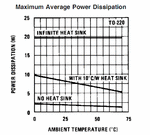csdave
Member level 5

Hi all,
same circuit, new question
I am using a 7805 to power a circuit using around 200mA but let's say 300mA to be on the safe side.
The input to the 7805 is a 9V transformer (after rectification obviously). Since 9V is effective voltage, the power dissipated by the 7805 should be 4*300 = 1.2W.
Does that require a heatsink? I would tend to say so, as I read somewhere, but can't remember where that the thermal resistance of the 7805 is 65K/W.
But how big should it be?
The project is to be contained in a plastic derivation box.
thanks
Davide
same circuit, new question
I am using a 7805 to power a circuit using around 200mA but let's say 300mA to be on the safe side.
The input to the 7805 is a 9V transformer (after rectification obviously). Since 9V is effective voltage, the power dissipated by the 7805 should be 4*300 = 1.2W.
Does that require a heatsink? I would tend to say so, as I read somewhere, but can't remember where that the thermal resistance of the 7805 is 65K/W.
But how big should it be?
The project is to be contained in a plastic derivation box.
thanks
Davide



